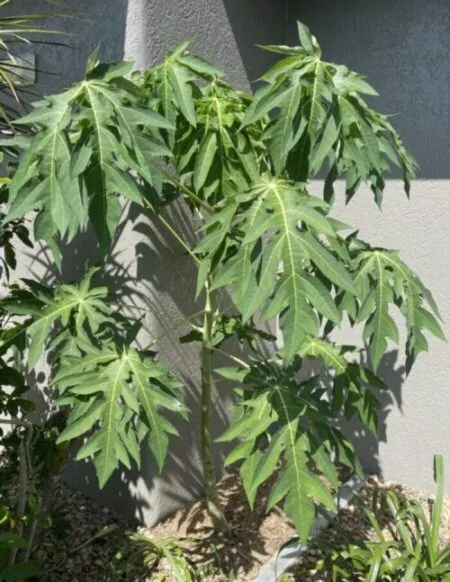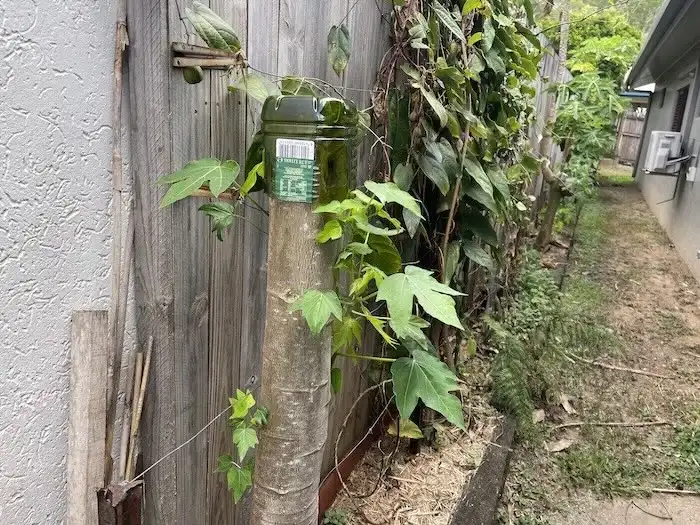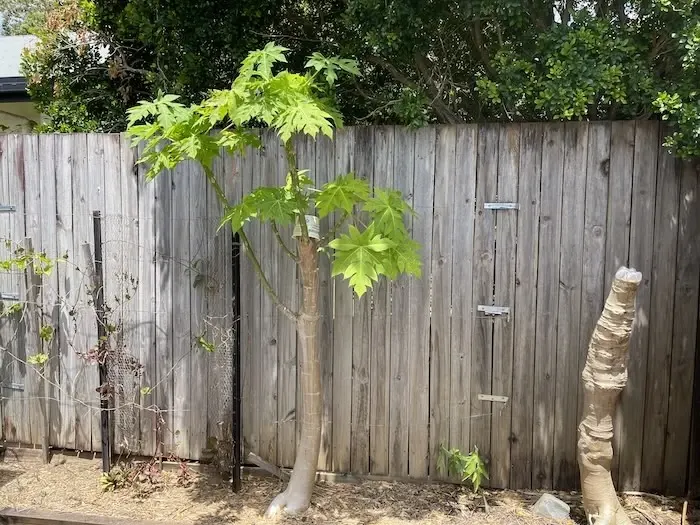Table of contents
Paw Paw Tree Care Australia
Paw paw tree care results in a crop of fruit known as paw paw or papaya. In Australia, New Zealand & South Africa the yellow version is called paw paw.
The paw paw tree has the botanical name Carica papaya. It is known as papaya in most of the world. However, in Australia, New Zealand and South Africa papaya only refers to the red fleshed version of the fruit. The yellow fleshed version is known to people in Australia as paw paw.
The plant is technically not a tree, but a tree-shaped herb. It fruits from the main trunk. Native to Mexico and South America, this plant has spread to other tropical regions. Indeed it is now loved in tropical gardens around the world.
Paw Paw Season Australia
Trees fruit well for more than 5 years. For this reason, it is best to stagger planting of trees. Annual planting ensures you have a fruitful harvest over future years.
In the tropics, this plant grows all year round. Like dragon fruit, the paw paw is very easy to grow. Flowering takes place over many weeks, so fruit can exist at different stages of development at the same time.
In the tropics this plant can fruit all year round. However, peak fruit production often occurs at the beginning of the wet season (summer) and towards the end of the wet season (autumn).

How to Grow Paw Paw Tree
The seeds from bisexual paw paw will breed true-to-type. Self-pollination in papaya does not appear to result in any loss of vigour.
Time needed: 5 minutes
How to Grow Paw Paw from Seed?
- Select Seed
Obtain a ripe paw paw grown on a ‘bisexual tree’ (which you can obtain from a plant nursery) and scoop out the seeds and pulp. Then rinse using a strainer and place remaining seed and pulp in a container of water and leave for a few days. Rinse again to remove remaining pulp from seeds (you may have to do this a few times).
- Dry Seeds
Dry seeds on dry paper and leave in a cool dark place for a few days.
When you are ready, plant in your seed tray or pot. Make sure you over-sow and when the seedings come up, simply thin out your seedlings, keeping the best ones. - Location.
Locate your plant in a sunny place in the garden with well-draining soil. However, if the soil is clay based, dig some gypsum in when planting.
- Planting
Make the hole two times as wide and the same depth as the root-ball. Remove the plant from the container, place it in the hole and backfill with soil. Water once a week during the dry season. Deep watering is more beneficial than shallow watering.
- Water
Water in well and thereafter water weekly for six weeks as the plant becomes established.
- Mulch
Mulch around the base with sugarcane, lucerne or other organic material. Keep mulch away from the trunk to avoid root rot.
- Fertilise
Provided soil is adequate, you need to fertilise just once each year, usually some time in spring.
- Pick fruit
Pick fruit when it is fully or at least half yellow and it will ripen on a bench inside.
Growing Paw Paw in Queensland
Growing paw paw (papaya) in Queensland is ideal due to the tropical climate. Choose a sunny, well-drained spot with shelter from strong winds.
What is the Best Fertiliser for Paw Paw Trees?
Nitrogen is vital for fostering lush leaves, phosphorus for robust roots and blossoms, and potassium for the overall well-being of the plant. For young papayas, use a balanced N-P-K ratio like 10-10-10 to cover all bases.
Paw Paw Propagation
Most paw paws have male and female flowers on separate trees, but there are bisexual trees available. Male flowers grow on long, thin stalks and there are usually multiple blooms. Female flowers are usually single blooms, held closely to the tree. However, we purchase the bisexual variety from the local nursery.
Paw Paw Tree Care in Pots
A 7 step plan to help you grow in a pot.
- Select a pot at least 600mm (24in) wide and deep.
- Position your pot in a place where it will get plenty of sun. Protecting the tree from strong winds is important.
- Fill the pot with good quality soil and make a hole in the middle. Place your paw paw in the hole and backfill with potting mix. Make sure to water in well.
- Mulch around the base with sugarcane, lucerne or other organic material. Keep mulch away from the trunk to avoid root rot.
- Water deeply once a week. During the ‘dry season’ you may need to water twice a week. However, if the plant is undercover and missing the ‘wet season’ you will need to water it twice a week all year around. If you live in the tropics and the pot is outside, it will probably only require watering during the dry season.
- Fertilise with manure or rich organic compost each year in spring and autumn.
- Pick the fruit when it is fully or at least half yellow and it will ripen on a bench inside.
How to Stop Paw Paw Tree from Growing Too Tall
Cut off your paw paw tree at waist height. Put a tin or container over the stump to stop water getting into the tree (or it will rot). Be patient and new branches will come out below the stump over coming weeks.

After a month or two the new branches will get stronger and before you know it, they will all be holding their own fruit.

Paw Paw Tree Problems
Aphids and caterpillars
Paw paw tree care includes keeping an eye out for aphids and caterpillars. However, if you only have a few trees, it is usually easy enough to just pick them off by hand. However, if your problem is larger, the application of ‘white oil’ can help address these pests. White oil is an effective organic pesticide. You can even make it at home.
Neem oil is also an organic option to address a variety of pests, including aphids, mealybugs, whiteflies, Japanese beetles, leafhoppers, thrips and other garden pests like spider mites and nematodes. Neem oil can also kill fungal infections such as powdery mildew, black spot, scab and leaf spot.
Paw Paw Tree Care and Fruit Fly
You can defend against fruit fly by hanging fruit fly traps around the trees. Also remove any fallen or rotting fruit promptly. The fruit fly hates it when you take its food away. Indeed we find that if you remove any fallen fruit daily, then a fruit fly trap will not be required.
Fruit Rot and Fungal Problems
Fruit rot and fungal infections are problems. However, one way they can be overcome is by picking the fruit early and ripening it on a bench inside.
Powdery mildew can attack the leaves and fruit. It can be addressed during the humidity of summer by ensuring good airflow around the plants. If that is not sufficient you can apply a recommended fungicide to your tree.
Pruning Pawpaw Trees Australia
Pruning a papaya tree involves removing damaged, diseased, or dead leaves and any suckers growing at the base to encourage healthy growth and fruiting. Cut back overly tall papayas for easier harvesting, ensuring cuts are made at an angle to prevent water pooling and rot.
Always use sterilised tools to avoid spreading disease. Pruning is best done in warmer months to minimise stress on the tree. Regular maintenance promotes airflow, sunlight penetration, and a more productive tree.
Paw Paw Tree Fruit
The fruit is technically a large berry. It is eaten ripe as a fruit. It is also used as a vegetable when picked green for a green salad. However, the ripe fruit has a sweet, custard-like flavour somewhat similar to mango or banana.
Hence, the fruit is commonly eaten directly with a spoon. However, it can also be used to make smoothies or even ice cream.
Uterine contractions in pregnant women.
Unripe fruit of the paw paw tree contain a latex, which may cause uterine contractions. While paw paw alone may not be the problem, it is important to know this. We could find no hard studies to back up the idea that the consumption of papaya is unsafe while pregnant. However, it may not be completely safe to eat while expecting. There is enough folklore around this issue in tropical areas, such as Far North Queensland to take the warning seriously.
Health Benefits
If you are not pregnant, the health benefits of this fruit are undeniable. Indeed the fruit is rich in nutrients. It is high in vitamin C and It also contains iron, magnesium and potassium. In addition, paw paw consumption helps to prevent constipation and heartburn.
Immune System
Paw paw has anti-inflammatory properties. It has been used to help with disorders such as rheumatoid arthritis and osteoarthritis. Paw paw also helps to treat common injuries of the joints and muscles.
Antioxidants
Studies claim that fermented paw paw can reduce oxidative stress, particularly in older adults and people with prediabetes, mild hypothyroidism and liver disease. Indeed, the reduction in oxidative stress is attributed to lycopene in the fruit and the ability to remove excess iron, which is known to produce free radicals.
Other Uses
Pure paw paw is used to produce ointment that can be used for things such as nappy rash, dry lips and more generally as a skin moisturiser.
Paw Paw Tree Bunnings
This plant is occasionally sold at Bunnings. You may find one in a small pot in the nursery section.
If you live in the tropics, why not consider supporting a local nursery? They often have what you need and a lot more besides. Also, often local nurseries sell plants suited to the local climate. In tropical areas, local nurseries often sell the paw paw tree.
Other Tropical Fruits
- Black Sapote
- Custard Apple
- Dragon Fruit
- Grumichama
- Guava Tree
- Jaboticaba
- Kumquat Tree
- Lemonade Tree
- Mamey Sapote Tree
- Mulberries
- Natal Plum
- Paw Paw
- Passion Fruit
- Rambutan
- Star Apple
- Watermelon


Comments
One response to “Paw Paw Tree Care Guide”
[…] Paw paw […]